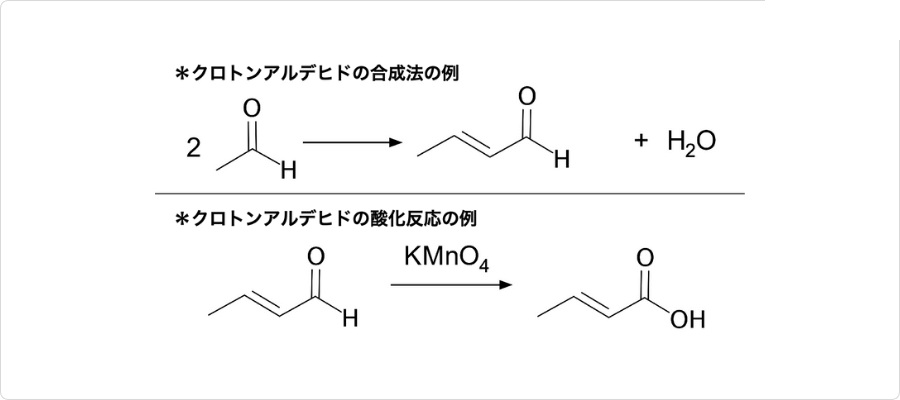-
種類
クロトンアルデヒドには前述の通り、2種類の幾何異性体が存在しますが、主にはトランス体が利用されています。そのため、製品として販売されているものもトランス体がほとんどです。
トランス体は、主には有機合成用の研究開発用試薬製品として販売されており、25mL , 500mLなど実験室で取り扱いやすい容量の種類があります。また、、水、メタノール溶液も製品として存在しています。
一方、シス/トランス混合物は、工業用の医薬品・農薬原料として購入することが可能です。こちらは、工場用途に向けて、タンクローリー・ドラム・石油缶、と大型の荷姿での提供となっています。
-
解説
クロトンアルデヒド,アセトアルデヒドを2分子縮合させて合成される.刺激臭のある無色の液体.融点-76.5 ℃,沸点104 ℃.d40"0.8715.nD173"1.4384.水蒸気蒸留できる.放置すると容易に重合する.酸化されてクロトン酸になりやすい.市販品は普通はトランス形である.
森北出版「化学辞典(第2版)
-
用途
ブタノール、ブチルアルデヒド等の合成原料
-
製造
アセトアルデヒドに塩化水素または塩化亜鉛を加えて加熱すると生ずるアルドールの脱水によって得られるクロトンアルデヒド。この方法で合成したものの二重結合の立体配置はトランス型である。工業的には,アルカリ触媒を用いたアルドール縮合と,酢酸触媒によるアルドールの脱水を組み合わせて製造する。
-
化学的特性
Crotonaldehyde is water-white (turns paleyellow on contact with air) with an irritating, pungent, suffocating odor.
-
物理的性質
Clear, colorless to straw-colored liquid with a pungent, irritating, suffocating odor. An odor
threshold concentration of 23 ppbv was reported by Nagata and Takeuchi (1990). Katz and Talbert
(1930) reported experimental detection odor threshold concentrations ranged from 180 to 570
μg/m3 (63 to 200 ppbv).
-
使用
Crotonaldehyde is used in organic synthesis, in the manufacture
of butyl alcohol and butyraldehyde, and as a warning
agent in fuel gases. It is also used in the manufacture of nbutanol
and sorbic acid as well as in the production of
flavoring agents, surface-active agents, textiles, and insecticidal
compounds.
-
定義
Commercial crotonaldehyde is the trans isomer.
-
一般的な説明
A clear colorless to straw colored liquid with a penetrating pungent odor. Flash point 55°F. Density 7.1 lb / gal. Very toxic by inhalation. May polymerize with the release of heat under exposure to heat or contamination. If polymerization takes place inside a container, the container may rupture violently. Less dense than water. Vapors heavier than air.
-
空気と水の反応
Highly flammable. Slightly soluble in water.
-
反応プロフィール
CROTONALDEHYDE can react violently with strong oxidizing reagents, e.g., reaction with conc. nitric acid leads to instantaneous ignition [Andrussow, L., Chim. Ind. (Paris), 1961, 86, p. 542]. In contact with strong acids or bases CROTONALDEHYDE will undergo an exothermic condensation reaction. Reaction with 1,3-butadiene is particularly violent [Greenlee, K. W., Chem. Eng. News, 1948, 26, p. 1985]. Crotonaldehyde may rapidly polymerize with ethyl acetoacetate (Soriano, D.S. et al. 1988. Journal of Chemical Education 65:637.).
-
危険性
An animal carcinogen. Irritating to
eyes, skin, and upper respiratory tract irritant.
Flammable, dangerous fire risk. Explosive limits
in air 2.9–15.5% by volume. Questionable carcinogen.
-
健康ハザード
CROTONALDEHYDE is an extreme eye, respiratory, and skin irritant and can cause corneal damage. A 15 minute exposure at 4.1 ppm is highly irritating to the nose and upper respiratory tract and causes tearing. Brief exposure at 45 ppm proved very disagreeable with prominent eye irritation.
-
火災危険
Flammable/combustible material; may be ignited by heat, sparks or flames. Vapor may travel to a source of ignition and flash back. Container may explode in heat of fire. Vapor explosion and poison hazard indoors, outdoors or in sewers. Runoff to sewer may create fire or explosion hazard. Readily converted by oxygen to hazardous peroxides and acids and is incompatible with caustics, ammonia, organic amines, mineral acids, and strong oxidizers. Readily resinifies to dimer when pure and slowly oxidizes to crotonic acid. Altered by light and air. Hazardous polymerization may occur. Polymerization may take place at high temperatures.
-
使用用途
クロトンアルデヒドの主な使用用途は、ブタノール、ブチルアルコールや、、などの有機化合物の合成原料です。これらの化合物は種々の工業品に利用されています。
例えば、クロトンアルデヒドを利用して合成されるブタノールは、カラー塗料やブレーキ液、燃料などに広く用いられています。また、クロトンアルデヒドは合成的に利用価値が高いことから、その他にも医薬品原料や農薬原料として活用されています。
研究開発においても有機合成の原料として利用されている物質です。
-
合成と化学反応

図3. クロトンアルデヒドの合成法と反応の例
クロトンアルデヒドは主にの縮合によって合成されます。また、アルドールを鉱酸と共に加熱し、反応物を蒸留することで得ることも可能です。
クロトンアルデヒドの反応性としては、アルデヒド基を有するため、重合しやすい性質があります。また、空気中に放置しておくと、徐々に空気中に含まれる酸素によって酸化されてクロトン酸となります。
-
法規制情報
クロトンアルデヒドは引火点が13℃と低く、引火性の物質です。そのため、消防法では「危険物第四類・第一石油類・危険等級Ⅱ」に指定されています。
また、蒸気には激しい刺激臭と催涙性があり、有毒であることが知られています。そのため、労働安全衛生法においては、「変異原性が認められた既存化学物質」、「健康障害防止指針公表物質」「名称を表示すべき危険物および有害物」などに措定されています。
取り扱いの際には、ゴーグルを使用するなど、注意が必要です。
参考文献
-
安全性プロファイル
Suspected carcinogen
with experimental carcinogenic data. Poison
by ingestion and inhalation. Mutation data
reported. An eye, skin, and mucous
membrane irritant. A lachrymating material
that can cause corneal burns and is very
dangerous to the eyes. Caution: Keep away
from heat and open flame. Keep container
closed. Use with adequate ventilation.
Extremely irritating to eyes, slim, mucous
membranes. When necessary, the
lachrymatory effect of the vapors may be
counteracted by ammonia fumes.
Dangerous fire hazard when exposed to heat
or flame; can react with oxidizing materials.
To fight fire, use alcohol foam, CO2, dry
chemical. Reacts violently with 1,3
butadlene. Violent hypergolic reaction with
concentrated nitric acid. When heated to
decomposition it emits acrid smoke and
fumes. See also ALDEHYDES.
-
職業ばく露
Crotonaldehyde is used as a warning agent in fuel gases and gas line leaks; as solvent; in Crotonaldehyde 935 chemical warfare; as an intermediate in the manufacture of n-butanol and crotonic and sorbic acids; in resin and rubber antioxidant manufacture; also used as a solvent in mineral oil purification; as an alcohol denaturant.
-
発がん性
Similar to acrolein, crotonaldehyde
is suspected of having tumorigenic activity and
of involvement in the metabolism of N-nitrosopyrrolidine
. Nevertheless, it has been proven that crotonaldehyde
does have a carcinogenic effect on rats. Indeed,
crotonaldehyde and nitrosopyrrolidine (a metabolite of
crotonaldehyde) induced neoplastic lesions in the liver,
hepatocellular carcinomas, neoplastic nodules, and liver
damage when administered orally to rats over long periods
of time.
-
特徴
シス型は融点-69℃ですが、利用が少ないこともあり、その他の物性的情報はあまり明らかになっていません。常温では液体で存在しており、無色透明です。
光や空気に触れると淡黄色に変化したり、刺激臭があったりすることが特徴です。
-
環境運命予測
Biological. Heukelekian and Rand (1955) reported a 10-d BOD value of 1.30 g/g which is
56.8% of the ThOD value of 2.29 g/g.
Chemical/Physical. Slowly oxidizes in air forming crotonic acid (Windholz et al., 1983). At
elevated temperatures, crotonaldehyde may polymerize (NIOSH, 1997).
Crotonaldehyde undergoes addition of water across the CH=CH bond yielding 3-
hydroxybutanal (Kollig, 1995).
At an influent concentration of 1,000 mg/L, treatment with GAC resulted in effluent
concentration of 544 mg/L. The adsorbability of the carbon used was 92 mg/g carbon (Guisti et
al., 1974).
-
輸送方法
UN1143 Crotonaldehyde or Crotonaldehyde, stabilized, Hazard class: 6.1; Labels: 6.1-Poison Inhalation Hazard, 3-Flammable liquid, Inhalation Hazard Zone B.
-
不和合性
Vapors may form explosive mixture with air. A strong reducing agent. Readily converted by oxygen to peroxides and acids; heat or contact with alkalis and many other substances may cause polymerization. Incompatible with oxidizers (chlorates, nitrates, peroxides, permanganates, perchlorates, chlorine, bromine, fluorine, etc.); contact may cause fires or explosions. Keep away from alkaline materials, strong bases, strong acids, oxoacids, epoxides, nonoxidizing mineral acids; ammonia, organic amines; aliphatic amines; aromatic amines; 1,3-butadiene, strong bases. Liquid attacks some plastics, rubber, and coatings
-
廃棄物の処理
Dissolve or mix the material with a combustible solvent and burn in a chemical incinerator equipped with an afterburner and scrubber. All federal, state, and local environmental regulations must be observed. May be absorbed on vermiculite and burned in open incinerator or dissolved in solvent and sprayed into incinerator






